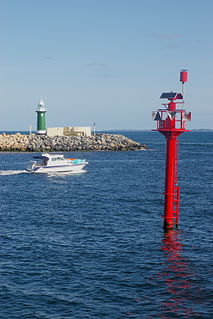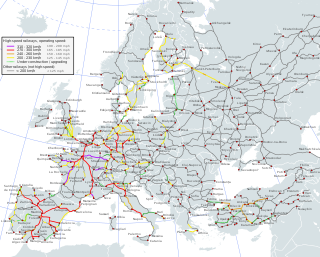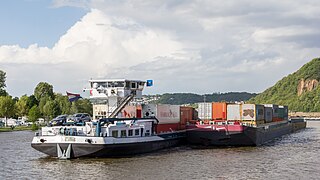The Trans-European Inland Waterway network is one of a number of the Trans-European Transport Networks (TEN-T) of the European Union.
The Trans-European Transport Networks (TEN-T) are a planned set of road, rail, air and water transport networks in the European Union. The TEN-T networks are part of a wider system of Trans-European Networks (TENs), including a telecommunications network (eTEN) and a proposed energy network. The European Commission adopted the first action plans on trans-European networks in 1990.

The European Union (EU) is a political and economic union of 28 member states that are located primarily in Europe. It has an area of 4,475,757 km2 (1,728,099 sq mi) and an estimated population of about 513 million. The EU has developed an internal single market through a standardised system of laws that apply in all member states in those matters, and only those matters, where members have agreed to act as one. EU policies aim to ensure the free movement of people, goods, services and capital within the internal market, enact legislation in justice and home affairs and maintain common policies on trade, agriculture, fisheries and regional development. For travel within the Schengen Area, passport controls have been abolished. A monetary union was established in 1999 and came into full force in 2002 and is composed of 19 EU member states which use the euro currency.
Contents
According to Article 11 of the Decision No 1692/96/EC [1] of the European Parliament and of the Council of 23 July 1996 on Community guidelines for the development of the Trans-European Transport Network, the Trans-European Inland waterway network is made up of rivers and canals, and the various branches and links which connect them. In particular, it should render possible the interconnection between industrial regions and major conurbations and link them to ports.

The European Parliament (EP) is the only parliamentary institution of the European Union (EU) that is directly elected by EU citizens aged 18 or older. Together with the Council of the European Union, which should not be confused with the European Council and the Council of Europe, it exercises the legislative function of the EU. The Parliament is composed of 751 members (MEPs), that will become 705 starting from the 2019–2024 legislature, who represent the second-largest democratic electorate in the world and the largest trans-national democratic electorate in the world.

The European Council is a collective body that defines the European Union's overall political direction and priorities. It comprises the heads of state or government of the EU member states, along with the President of the European Council and the President of the European Commission. The High Representative of the Union for Foreign Affairs and Security Policy also takes part in its meetings. Established as an informal summit in 1975, the European Council was formalised as an institution in 2009 upon the entry into force of the Treaty of Lisbon. Its current President is Donald Tusk, former Prime Minister of Poland.
The minimum technical characteristics for waterways forming part of the network should be those laid down for a class IV waterway in the classification of European Inland Waterways (CEMT), which allows the passage of a vessel or a pushed train 80-to-85-metre-long (260 to 280 ft) and 9.50-metre-wide (31 ft). Where a waterway forming part of the network is modernized or constructed, the technical specifications should correspond at least to class IV, should enable class Va/Vb to be achieved at a later date, and should make satisfactory provision for the passage of vessels used for combined transport. Class Va allows the passage of a vessel or a pushed train of craft 110 m long and 11.40 m wide, and class Vb allows the passage of a pushed train of craft 172 to 185 m long and 11.40 m wide.

The Classification of European Inland Waterways is a set of standards for interoperability of large navigable waterways forming part of the Trans-European Inland Waterway network within Continental Europe and Russia. It was created by the European Conference of Ministers of Transport in 1992, hence the range of dimensions are also referred to as CEMT Class I–VII.










